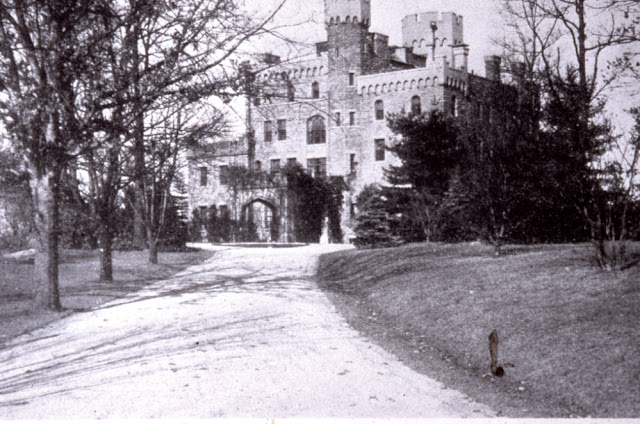Halsey's Castle: Its 1977 demise sounded a death knell for Irvington's historic estates
"Halsey’s Castle" was one of the last of the crenellated Rhine-style mansions left standing in the Village of Irvington.
Originally named "Rochroane," it was a 44-room stone mansion on a 200-acre estate on a hill east of South Broadway overlooking the Hudson River. It was designed and constructed by New York architect and Irvington resident Arthur J. Manning between 1902 and 1905 for Melchior S. Beltzhoover, an oil and cotton millionaire from Natchez, Miss.
Beltzhoover, 32 at the time, was already living in Irvington at the time of the 1900 U.S. census. He lived with his wife, 38-year-old Virginia Lee Koontz Beltzhoover, a son and daughter, 8 and 1 respectively, and his brother-in-law, Alex. The family lived with eight servants: Two listed only as servants, as well as a laundress, a cook, a butler, a coachman and a nurse.
Beltzhoover's estate, which had an entrance off Harriman Road and abutted today’s Ardsley Park and Ardsley Country Club to the south, was built in the style of a Rhine River castle and featured a spectacular stained-glass window by Louis Comfort Tiffany that depicted the Hudson River view as seen from the castle in springtime from the mansion’s music room.
Beltzhoover, who served as President of Irvington’s Board of Trustees from 1904-1916 -- the equivalent of mayor today -- died at his wife’s family’s Natchez estate Green Leaves at age 50 in 1918.
He had suffered severe financial reversals during World War I and his castle and a portion of the estate were put up for sale by his widow in 1920. The repackaged 44-acre estate was sold to the family of textile manufacturer James D. Shields, president of the Standish Worsted Company. It was the Shields family that renamed the castle “Grey Towers” or “Gray Towers.”
A story on the sale in Oct. 15, 1920 issue of The Irvington Gazette newspaper brings the estate’s scope into focus:
“The house includes twelve master bedrooms with eight baths and affords accommodations for fifteen servants. The interior is furnished throughout with the most modern conveniences, including an electric elevator running from the basement to the fourth floor.
“The upper story of an eight-car garage has been equipped for the housing of the families of the caretaker and chauffeur. A huge brick dairy looks out upon extensive pastureland to the north adjacent to which are hot houses and chicken runs.
“The major portion of the land, consisting of 44 acres, has been beautifully landscaped, a natural lake consisting of five acres standing out as one of the principal features. Stone grottoes are to be found along graceful paths which wind in and out among flowering shrubs and evergreens. Private driveways running through the estate measure over a mile and are well macadamized. At the foot of a knoll south of the estate, a tennis court has been built upon a terrace overlooking the lake.”
The estate also included a cottage for the gardener’s family. The garage doubled as coach house and stables in the earliest days of the estate.
The Shields family rented out the estate during many of the seven summers they owned it, eventually selling the property to Benjamin Schuyler Halsey, son of the founder of the Sheffield Farms Co., in January 1927. Halsey’s purchase of the estate led to the popular name “Halsey’s Castle.”
The Halsey family introduced large-scale pasteurization of dairy products into the U.S. Pasteurization was a major health breakthrough, eliminating the transmission of tuberculosis, scarlet fever and typhoid fever -- among other diseases -- via milk products.
Halsey valued his mansion and estate at $210,000 in the 1930 federal census -- $3.3 million today, adjusted for inflation.
The Halseys lived in the main house on the estate with five children, ages 5 to 15, and a pair of single women servants, both 25, one identified as "waitress," the other a children's nurse. Living in another pair of houses on the estate at the time were a chief gardener and his family and the estate superintendent and his family.
Benjamin Halsey died in late 1956 at age 83 and his widow Katharine Walsh Halsey, 20 years his junior, remained on the property. She donated the estate to Irvington’s Immaculate Conception Church in 1976. The church sold the property including the castle soon after to fund construction of a new church since it’s own mid-19th century church, purchased from the Irvington Presbyterian Church in 1869, had been destroyed by fire, apparently set by an arsonist, several years earlier.
The castle itself burned in 1977 after being sold to developers, but the famed Tiffany window had already been removed and was saved. The castle was torn down shortly thereafter and rezoned for the construction of homes in what is now Halsey Lake Estates south of Harriman Road.
The only part of the original estate that remains is the stone Beltzhoover Teahouse at Halsey Pond Park, a 30-acre preserve donated to the Village of Irvington by developers in return for the right to subdivide the rest of the property.












Comments
Post a Comment
If you would like to weigh-in, feel free ...